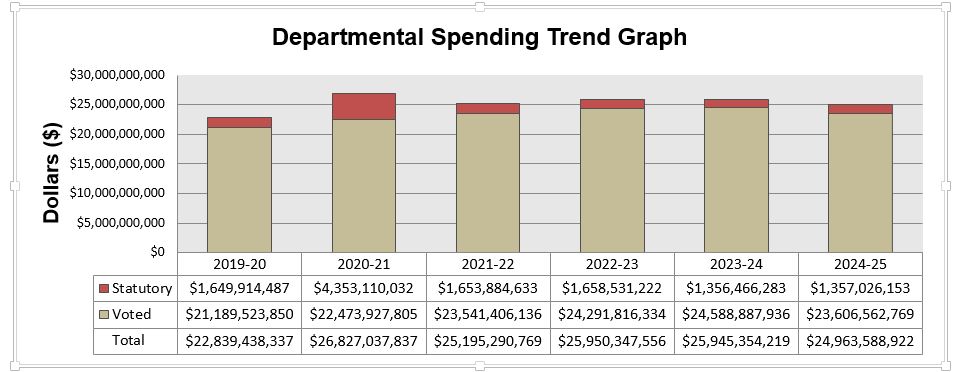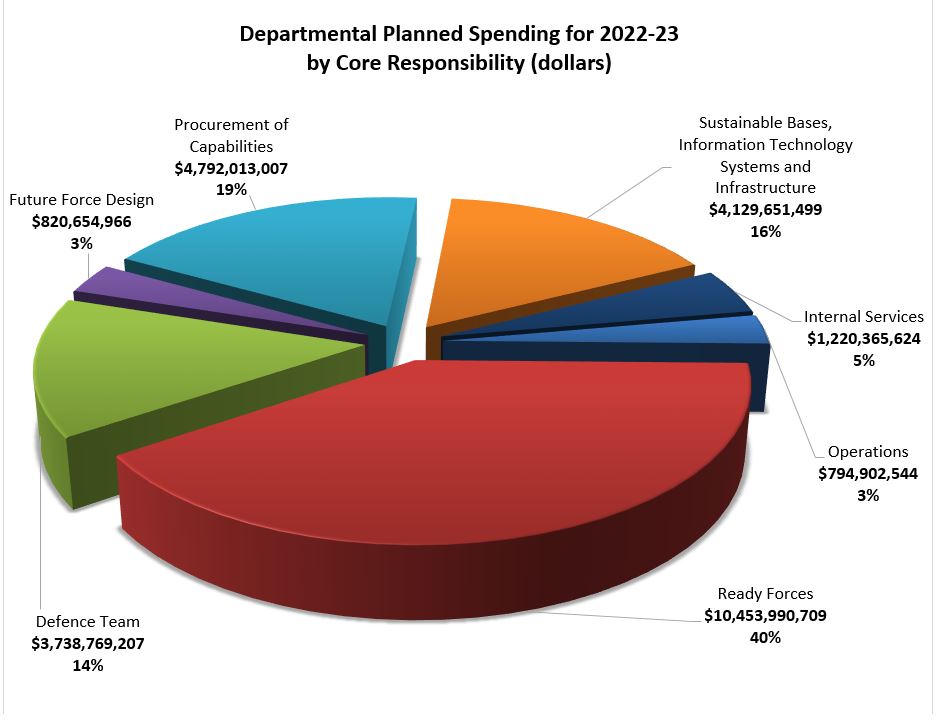Planned spending and human resources
This section provides an overview of the department’s planned spending and human resources for the next three fiscal years and compares planned spending for 2022-23 with actual spending for the current year and the previous year.
Planned spending
Departmental spending 2019-20 to 2024-25
Departmental spending trend graph
The following graph presents planned (voted and statutory expenditures) spending over time.

Notes: Due to rounding, figures may not add up to totals shown.
Description of Figure: Departmental Spending Trend
This bar graph depicts Defence's financial spending trend starting with fiscal year 2019-20.
On the Y-axis are dollars ranging from 0 to 30,000,000,000. On the X-axis is Fiscal Year 2019-2020 through 2024-2025.
Statutory Financial Spending Trend is:
- $1,649,914,487 in 2019-20;
- $4,353,110,032 in 2020-21;
- $1,653,884,633 in 2022-23;
- $1,658,531,222 in 2022-23;
- $1,356,466,283 in 2023-24; and
- $1,357,026,153 in 2024-25.
Voted Financial Spending Trend is:
- $21,189,523,850 in 2019-20;
- $22,473,927,805 in 2020-21;
- $23,541,406,136 in 2021-22;
- $24,291,816,334 in 2022-23;
- $24,588,887,936 in 2023-24; and
- $23,606,562,769 in 2024-25.
Total Financial Spending Trend is:
- $22,839,438,337 in 2019-20;
- $26,827,037,837 in 2020-21;
- $25,195,290,769 in 2021-22;
- $25,950,347,556 in 2022-23;
- $25,945,354,219 in 2023-24; and
- $24,963,588,922 in 2024-25.
Budgetary planning summary for Core Responsibilities and Internal Services (dollars)
The following table shows information on spending for each of the Department of National Defence and the Canadian Armed Forces’ core responsibilities and for its internal services for 2022-23 and other relevant fiscal years.
| Core Responsibilities and Internal Services | 2019–20 Expenditures | 2020–21 Expenditures | 2021–22 Forecast spending | 2022–23 budgetary spending (as indicated in Main Estimates) | 2022–23 Planned spending | 2023–24 Planned spending | 2024–25 Planned spending |
|---|---|---|---|---|---|---|---|
| Operations | 1,044,514,772 | 1,028,857,684 | 1,112,553,924 | 794,902,544 | 794,902,544 | 806,647,190 | 814,971,524 |
| Ready Forces | 9,875,229,209 | 11,719,160,120 | 10,292,348,934 | 10,453,990,709 | 10,453,990,709 | 10,458,121,831 | 10,637,852,995 |
| Defence Team | 3,365,827,143 | 4,057,640,230 | 3,859,083,052 | 3,738,769,207 | 3,738,769,207 | 3,752,774,854 | 3,798,539,154 |
| Future Force Design | 758,767,328 | 836,173,606 | 754,558,732 | 820,654,966 | 820,654,966 | 818,760,419 | 821,095,511 |
| Procurement of Capabilities | 3,298,055,560 | 4,119,915,713 | 4,195,092,477 | 4,792,013,007 | 4,792,013,007 | 5,127,882,945 | 3,894,787,550 |
| Sustainable Bases, Information Technology Systems and Infrastructure | 3,651,639,001 | 4,185,750,629 | 3,988,447,423 | 4,129,651,499 | 4,129,651,499 | 4,105,845,151 | 4,107,345,584 |
| Subtotal | 21,994,033,013 | 25,947,497,982 | 24,202,084,542 | 24,729,981,932 | 24,729,981,932 | 25,070,032,390 | 24,074,592,318 |
| Internal Services | 845,405,324 | 879,539,855 | 993,206,227 | 1,220,365,624 | 1,220,365,624 | 875,321,829 | 888,996,604 |
| Total | 22,839,438,337 | 26,827,037,837 | 25,195,290,769 | 25,950,347,556 | 25,950,347,556 | 25,945,354,219 | 24,963,588,922 |
Sources: Vice-Chief of the Defence Staff Group / Assistant Deputy Minister (Finance) / Chief Financial Officer Group (CFO).
Notes: Due to rounding, figures may not add up to totals shown.

Notes: Due to rounding, figures may not add up to totals shown.
Description of graphic: Departmental Planned Spending for 2021-22 by Core Responsibility (dollars)
This pie chart illustrates the Department of National Defence's spending for Fiscal Year 2022-23, broken down by Core Responsibility.
The percentages allocated to each section, from largest to smallest, are:
- 40%, $10,453,990,709 for Ready Forces;
- 19%, $4,792,013,007 for Procurement of Capabilities;
- 16%, $4,129,651,499 for Sustainable Bases, Information Technology Systems and Infrastructure;
- 14%, $3,738,769,207 for Defence Team;
- 5%, $1,220,365,624 for Internal Services;
- 3%, $820,654,966 for Future Force Design; and
- 3%, $794,902,544 for Operations.
Planned human resources
The following table shows information on human resources, in full-time equivalents (FTEs), for each of the Department of National Defence and the Canadian Armed Forces’ core responsibilities and for its internal services for FY 2022-23 and the other relevant years.
Human resources planning summary for core responsibilities and internal services
| Core Responsibilities and Internal Services | 2019-20 actual full-time equivalents |
2020-21 actual full-time equivalents | 2021-22 forecast full-time equivalents | 2022–23 planned full-time equivalents | 2023–24 planned full-time equivalents | 2024–25 planned full-time equivalents |
|---|---|---|---|---|---|---|
| Operations | 2,647 | 2,156 | 3,078 | 2,144 | 2,145 | 2,151 |
| Ready Forces | 45,797 | 45,431 | 46,716 | 45,920 | 45,957 | 46,052 |
| Defence Team | 20,407 | 18,902 | 18,059 | 19,127 | 19,123 | 19,166 |
| Future Force Design | 1,930 | 1,883 | 2,086 | 1,914 | 1,887 | 1,885 |
| Procurement of Capabilities | 2,427 | 2,525 | 2,843 | 2,429 | 2,419 | 2,427 |
| Sustainable Bases, Information Technology Systems and Infrastructure | 15,974 | 15,944 | 16,493 | 15,526 | 15,455 | 15,503 |
| Subtotal | 89,182 | 86,841 | 89,275 | 87,060 | 86,986 | 87,184 |
| Internal Services | 4,070 | 4,342 | 4,470 | 4,284 | 4,277 | 4,296 |
| Total | 93,252 | 91,183 | 93,745 | 91,344 | 91,263 | 91,480 |
Total planned human resources – Reserve Force personnel
The Reserve Force is a valued and integrated component of the CAF. It is divided into four distinct sub-components:
- Primary Reserve;
- Cadet Organization Administration and Training Service;
- Canadian Rangers; and
- Supplementary Reserve (Strategic Reserve).
The Primary Reserve (P Res) consists predominately of part-time professional CAF members, located throughout Canada, ready with reasonable notice to conduct or contribute to domestic and international operations to safeguard the defence and security of Canada. The CAF will continue its efforts in meeting the overall Defence Policy objective to maximize the operational output of the P Res (full-time capability through part-time service) through the conception, development, funding, sustainment and integration of unique enablers and new or existing combat multipliers. These efforts will support the P Res to reach the Government of Canada (Strong, Secure, Engaged initiative 74) authorized Average Paid Strength level to 30 000.
The Cadet Organizations Administration and Training Service (COATS) sub-component consists predominantly of part-time CAF members, located throughout Canada, primarily assigned to duties relating to the supervision, administration and training of cadets who are members of the Royal Canadian Sea Cadets, Royal Canadian Army Cadets and Royal Canadian Air Cadets. It is currently comprised of 7 052 CAF members in one of three military occupations; Cadet Instructors Cadre (CIC) officers, General Service Officers and General Service Non-Commissioned Members (NCMs). The current target strength of 8 000 COATS personnel is required to support the CAF’s responsibility for the Department’s Youth Program (Cadets and Junior Canadian Rangers).
The target of 5 680 Canadian Ranger personnel is an aspirational target and would represent an increase of eight percent from present levels. Although growth was paused in FY 2020-21 in order to limit the risk of transmitting COVID-19 to isolated communities, Canadian Ranger Enhancement seeks to reinvigorate growth utilizing available resources and ensuring recruiting targets are aligned with the needs of communities where growth is forecast.
The following table provides our total planned human resources for Reserve Force personnel for the next three FY’s 2022-25.
| - | 2022–23 | 2023–24 | 2024–25 |
|---|---|---|---|
| Primary Reserve | 29,250 | 29,550 | 30,000 |
| Cadet Organization Administration and Training Service | 7,250 | 7,500 | 8,000 |
| Canadian Rangers | 5,680 | 5,680 | 5,680 |
Estimates by vote
Information on the Department of National Defence and the Canadian Armed Forces’ organizational appropriations is available in the 2022-23 Main Estimates.
Future-oriented condensed statement of operations
The future-oriented condensed statement of operations provides an overview of the Department of National Defence and the Canadian Armed Forces’ operations for 2021-22 to 2022-23.
The forecast and planned amounts in this statement of operations were prepared on an accrual basis. The forecast and planned amounts presented in other sections of the Departmental Plan were prepared on an expenditure basis. Amounts may therefore differ.
A more detailed future‑oriented statement of operations and associated notes, including a reconciliation of the net cost of operations to the requested authorities, are available on the Department of National Defence and the Canadian Armed Forces’ website.
Future-oriented Condensed statement of operations for the year ending 31 March 2023 (dollars)
| Financial information | 2021–22 forecast results | 2022–23 planned results | Difference (2022-23 planned results minus 2021-22 forecast results) |
|---|---|---|---|
| Total expenses | 24,981,171,000 | 25,390,997,000 | 409,826,000 |
| Total revenues | 408,586,000 | 407,990,000 | (596,000) |
| Net cost of operations before government funding and transfers | 24,572,585,000 | 24,983,007,000 | 410,422,000 |
Notes: The variance between the 2022–23 planned results and 2021–22 forecast results is mainly due to an increase in salary and employee benefits as well as an increase in amortization expense.